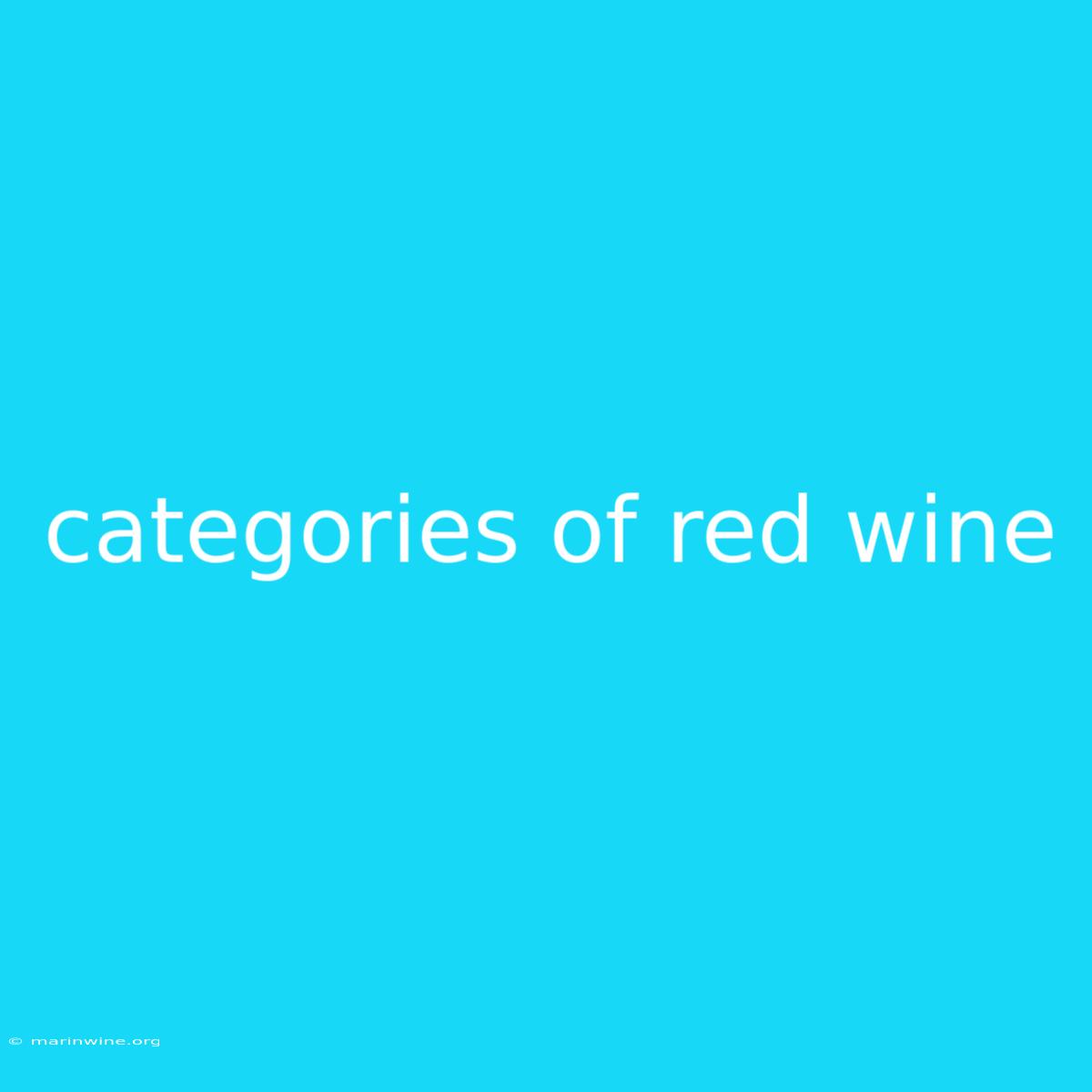Uncorking the Secrets: Exploring the Categories of Red Wine
Have you ever wondered what makes a Cabernet Sauvignon different from a Pinot Noir? The world of red wine is vast and diverse, offering a spectrum of flavors and experiences. Understanding the different categories of red wine can help you navigate this exciting landscape and discover your perfect glass.
Why It Matters: Knowing the categories of red wine allows you to explore the nuances of different grape varietals and their unique characteristics. You can make more informed decisions about what to buy, pair your wine with food, and appreciate the complexities of each bottle.
Key Takeaways of Red Wine Categories:
| Category | Key Characteristics |
|---|---|
| Light-bodied | Fruity, refreshing, low tannins |
| Medium-bodied | Balanced, versatile, moderate tannins |
| Full-bodied | Rich, complex, high tannins |
| New World | Bold, fruit-forward, often oaked |
| Old World | Earthy, complex, often lighter in body |
Red Wine Categories: A Deeper Dive
Light-bodied Red Wines
Introduction: Light-bodied red wines are known for their lighter color, lower tannins, and refreshing acidity. They are often characterized by bright fruit flavors and a gentle finish.
Key Aspects:
- Grape Varietals: Pinot Noir, Gamay, Dolcetto, Grenache, Zweigelt
- Flavor Profile: Red berries (cherry, raspberry, strawberry), floral notes, earthy hints
- Food Pairings: Light dishes, poultry, salmon, pasta with lighter sauces
- Examples: Beaujolais, Pinot Noir from Burgundy, Valpolicella
Medium-bodied Red Wines
Introduction: Medium-bodied red wines offer a balance between light and full-bodied styles. They possess moderate tannins, a fuller flavor profile, and a longer finish.
Key Aspects:
- Grape Varietals: Merlot, Sangiovese, Zinfandel, Syrah, Tempranillo
- Flavor Profile: Black fruit (blackberry, plum), spice (pepper, cinnamon), vanilla, chocolate
- Food Pairings: Red meats, roasted vegetables, hearty cheeses, pasta with rich sauces
- Examples: Chianti, Rioja, Bordeaux, Côtes du Rhône
Full-bodied Red Wines
Introduction: Full-bodied red wines are characterized by their deep color, high tannins, and concentrated flavors. They are robust and complex, often requiring time to develop.
Key Aspects:
- Grape Varietals: Cabernet Sauvignon, Cabernet Franc, Petite Sirah, Malbec, Shiraz
- Flavor Profile: Dark fruit (blackberry, plum, cassis), leather, tobacco, cedar, oak
- Food Pairings: Game meats, grilled steaks, aged cheeses, rich desserts
- Examples: Napa Valley Cabernet Sauvignon, Bordeaux, Barolo, Mendoza Malbec
New World vs. Old World Wines
Introduction: The terms "New World" and "Old World" refer to the regions where winemaking traditions have evolved over centuries.
New World:
- Regions: North and South America, Australia, New Zealand
- Characteristics: Fruit-forward, bold, often oaked, high alcohol content
- Examples: Californian Zinfandel, Chilean Cabernet Sauvignon, Australian Shiraz
Old World:
- Regions: Europe (France, Italy, Spain, Portugal)
- Characteristics: Earthy, complex, often lighter in body, subtle aromas, traditional winemaking techniques
- Examples: Burgundy Pinot Noir, Bordeaux blend, Italian Sangiovese, Spanish Rioja
Information Table
| Wine Category | Grape Varietals | Key Flavors | Food Pairings |
|---|---|---|---|
| Light-bodied | Pinot Noir, Gamay | Red berries, floral | Poultry, salmon, light dishes |
| Medium-bodied | Merlot, Sangiovese | Black fruit, spice | Red meats, roasted vegetables |
| Full-bodied | Cabernet Sauvignon | Dark fruit, leather | Game meats, grilled steaks |
FAQ for Red Wine Categories
Q: What are tannins in wine?
A: Tannins are natural compounds found in grape skins, seeds, and stems that contribute bitterness, astringency, and structure to wine.
Q: How do I know if a red wine is aged?
A: Look for the vintage year on the bottle. Older wines generally have more complex flavors and a smoother texture.
Q: How can I tell if a wine is good or bad?
A: There's no single answer. Enjoy what you like! Look for signs of spoilage like vinegar or mold.
Q: What is the best way to learn about red wine?
A: Attend wine tastings, read books, and explore different regions. Experiment with various wines and build your palate!
Tips for Enjoying Red Wine
- Temperature: Serve red wines slightly chilled, around 60-65°F (15-18°C)
- Decanting: Decant full-bodied wines to allow them to breathe and release their aromas.
- Glassware: Use a Burgundy glass for light-bodied wines and a Bordeaux glass for full-bodied wines.
- Pairing: Match the weight and intensity of the wine with the food.
- Storage: Keep red wines in a cool, dark place.
Summary of Red Wine Categories
This exploration has uncovered the fascinating world of red wine categories. By understanding the differences in body, flavor profiles, and regions, you can navigate this exciting landscape with confidence. From the bright and refreshing notes of Pinot Noir to the robust complexities of Cabernet Sauvignon, there's a perfect glass of red wine waiting for you.
Closing Message: As you continue your journey through the world of wine, embrace experimentation. Taste different wines, discover your favorites, and appreciate the artistry and diversity that make red wine a truly unique and captivating beverage.

